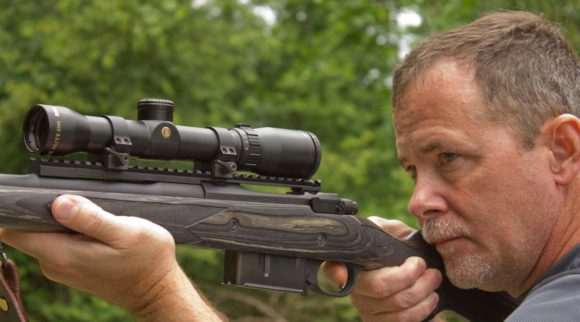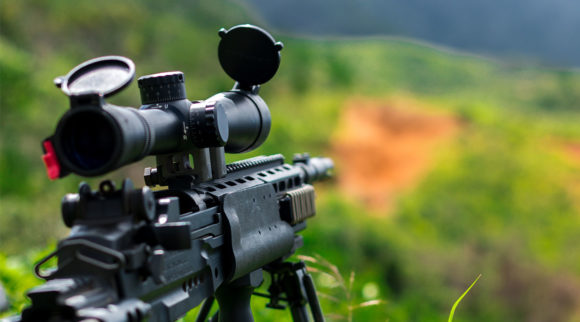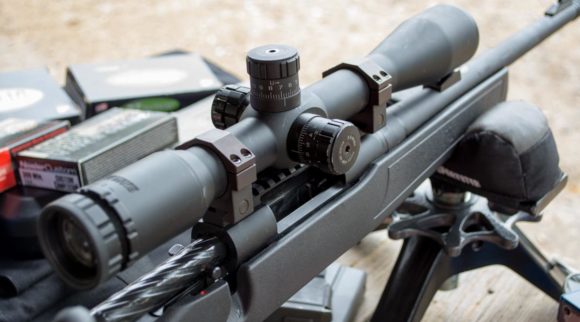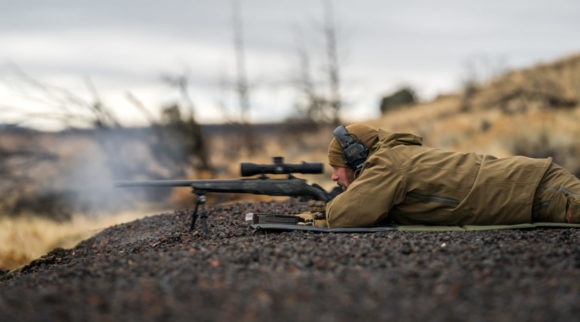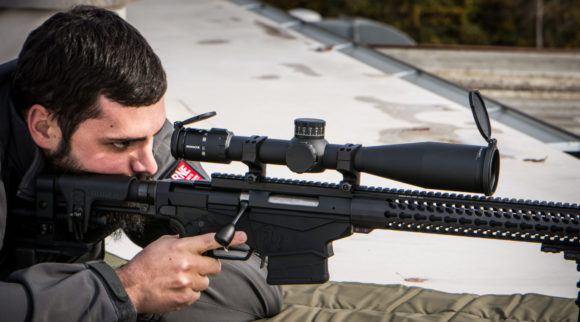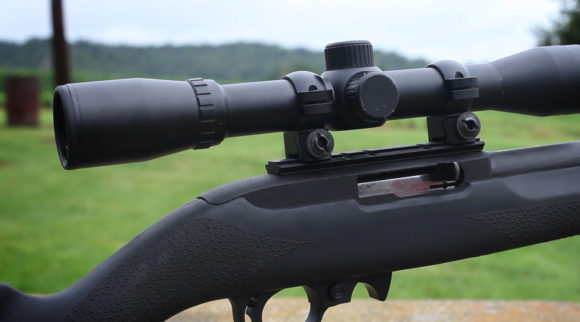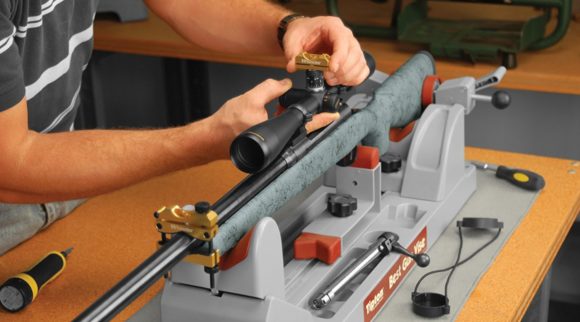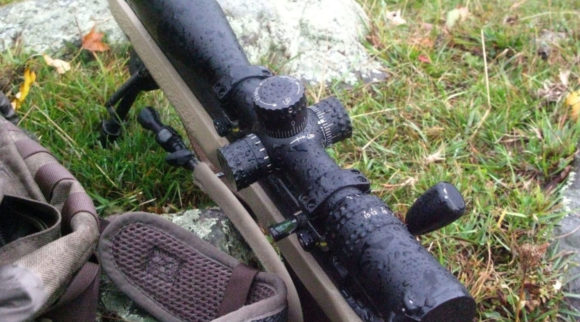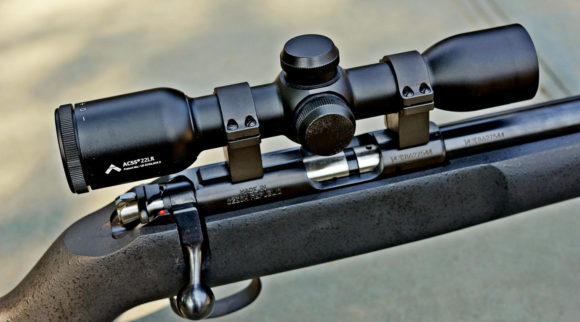Rifle Scope Turrets Explained | How To Adjust A Rifle Scope by BestGunScope.com

Whether you own a rifle for hunting, target shooting, or tactical reasons a scope can enhance your aim and accuracy. There are many types of rifle scopes on the market today and it is important to choose the right scope for the type of shooting you are doing. In addition to purchasing the right scope, you will need to know how the scope works and how to adjust it. To get a better understanding of rifle scopes refer to the sections below on rifle scopes, scope turrets, how to adjust rifle scope turrets, and how to properly maintain your rifle scope. After reading this you should have the knowledge and confidence you need to purchase, use, and care for a rifle scope.
See Top Article: Best Rifle Scope
Rifle Scope
Rifle Scopes allow the shooter to align the barrel of their rifle with their target increasing the accuracy of their shot. They work under the same principal as telescopes and use light passing through different lenses to magnify an image. There are many factors that go into purchasing the proper rifle scope. These factors include:
- Shooting Distance– The distance from which you will be shooting will impact how much magnification your scope will need. Magnification is indicated by a number the symbol “X” and is the power rating of the scope, for example, 10X will make the target seem 10 times closer than if the shooter was looking with the naked eye. Magnification is important because bigger isn’t always better it depends on where and what you will be shooting. For example, an individual shooting at a target 1000 yards away would not be able to aim appropriately with a 5X scope and conversely, an individual shooting at game 100 yards away would not be able to aim properly with a 30X scope.
- Light Conditions– The type of rifle scope you want to purchase will depend on what light conditions you will be shooting under. If you plan on hunting at night or early in the morning when there is not much light you will want to choose a rifle scope that utilizes night vision technology. If you do most of your shooting at targets in full light then you obviously will not need to spend extra money on a scope with night vision technology.
- Type of Reticle– The reticle ( or crosshairs) is the lines or dots in your rifle scope that are superimposed on your target to help a shooter aim by giving them a distinct centralized point. Reticles come in several different styles and include Dot, German, Duplex, BDC, Mil, Illuminated, Non-Illuminated, and Christmas Tree. The type of reticle you choose is going to be based on the type of hunting you will be doing and also personal preference.
- Weight– The larger the scope the heavier it will be and larger scopes are better at managing light. If most of your shooting is from a stationary position than weight may not matter, but if your shooting involves long hikes than you may want a smaller scope as it will weigh less.
- Price– Rifle scopes vary in price from $20-$5500, if you are looking for a good yet relatively inexpensive rifle scope you will probably be more in the $200 range. It is important to remember you get what you pay for and you probably don’t want to put a $35 scope on a $1000 rifle. Again this is all up to personal choice as well as budget restrictions.
It is important to understand the different parts of a rifle scope so you have a better understanding of how a rifle scope works and which is best for your shooting needs.
- Main Body– A rifle scope is composed of two tubes, the outer tube protects the scope components and is the part that is mounted to the rifle, and the inner tube contains the lenses and other rifle scope components.
- Ocular Lens– This is the part of the scope that faces the shooter when they aim and focuses the light gathered by the objective bell and objective lens.
- Eyepiece– This is the part of the scope that holds the ocular lens and where the shooter looks through.
- Power Ring– The part of the scope that is used to adjust the magnification.
- Scope Tube– The part of the scope that bridges the object and ocular lens and comes in two different sizes 30mm and 1 inch.
- Windage Turret– The part of the scope that adjusts the horizontal alignment and is found on the right side of the scope.
- Elevation Turret– The part of the scope that adjusts the vertical alignment and is found on the top of the scope.
- Objective Bell– The part of the scope that holds the objective lens and collects the light.
- Objective Lens– The part of the scope farthest away from the shooter that gathers the target image.
Scope Turrets
 Scope turrets are the knobs on the top and side of the scope that help to enhance shooters accuracy. While there are different types of turrets the primary ones are the knobs to adjust windage and elevation.
Scope turrets are the knobs on the top and side of the scope that help to enhance shooters accuracy. While there are different types of turrets the primary ones are the knobs to adjust windage and elevation.
- Windage Turret– The windage turret is the knob located on the right side of the scope and is used to adjust the horizontal alignment. When you shoot your rifle adjusting the windage turret will adjust your vision to the path of the bullet to the right or left of your true aim. This adjustment allows for better accuracy as the shooter can compensate for wind in the location they are shooting from.
- Elevation Turret– The elevation turret is the knob located on the top of the scope and is used to adjust the vertical alignment. When you shoot your rifle, adjusting the elevation turret will adjust your vision to the path of the bullet either up or down.
While scope turrets are the part of the scope that adjusts for windage and elevation, all turrets are not the same. Below is a list of the different type of turrets you can buy:
- Exposed– Turrets that are exposed are easier to adjust and shooters can easily see what their settings are. This is the best choice for situations that involve moving targets and changing weather conditions.
- Capped– Turrets that come with protective caps are best for individuals who shoot in the same conditions like hunters who shoot from a tree stand in the same season because the conditions are the same there is no need to be constantly adjusting the turrets. Another reason an individual may choose turrets with protective caps is to avoid the accidental movement of the turrets.
- Key– Key turrets require the shooter to use a tool such as a screwdriver or Allen wrench to adjust the turret and are popular among marksmen who shoot under the exact same conditions all the time and want to make sure their turret settings are protected.
- Ballistic– Ballistic turrets are components that are situated on top of the elevation turret and have markings on them in 100-yard increments allowing shooters to adjust and compensate for bullet drop from known distances.
- Custom– Shooters also have the option of customizing their turrets for their type of shooting. Individuals can add different knobs and dials that they feel best suits their type of hunting although it is important to note that these aftermarket adjustments may void the warranty that came with your scope.
How to Adjust Scope Turrets
When adjusting your rifle scope you will be doing so in specific increments and the most common are inches, 1/4-inch or 1/8-inch increments, or MOA (minutes of angle). As you turn or click any of the adjustment knobs on the scope you are adjusting it in one increment. (If you are unsure what increments your rifle scope uses you may need to refer to your manual). Continue reading to learn how to adjust a rifle scope up and down.
Related: Best Thermal Scope
Windage
When adjusting for windage you are moving the reticle to the left or right in order to center your shot in your sight. Windage is often measured in MOA (minutes of angle) and is equal to approximately 1″ per 100 yards or if you adjust your windage turret one click the bullet will hit one inch to the left or right at a 100-yard distance.
A simple formula to use is:
(distance to the target in yards)/ (100) = inches per MOA at that distance
(number of inches of adjustment needed)/ (inches per MOA at that distance)= MOA adjustment
(number of clicks per 1 MOA on scope) X (MOA adjustment)= adjustment in clicks on the scope
Now let’s take an example and plug it into the formula above:
Example= Bullets are impacting 16” to the left at 800 yards
800/100= 8 inches per MOA
16/8= 2 MOA adjustment
1X2= 2 clicks on the scope
Since the bullets are impacting to the left, you need to adjust to the right
So you will need to adjust your scope 2 clicks to the right.
If you have a computer or smartphone handy and prefer to not do the math above you can plug your contingencies into the following site (click here) and find MOA.
Elevation
When adjusting for elevation you are moving the reticle up or down in order to center your shot in your sight. Luckily, how to adjust a rifle scope up and down utilizes the same principle as that of windage, the only difference is in the direction. You can plug your numbers into the formula above and remember that when it comes to the clicks on the scope you will be clicking either up or down.
 How to Properly Maintain Your Rifle Scope
How to Properly Maintain Your Rifle Scope
Now that you have purchased your rifle scope and understand how to adjust the scope turrets, you will need to properly maintain your scope to ensure that your aim is true. While rifle scopes are manufactured and designed to withstand some pretty harsh conditions, it is still important to properly clean and store them to keep them in to shape. Below is a list of tips on how to properly maintain your rifle scope:
-
- Lens Cap– While this seems like a no-brainer it is a simple tip that may get overlooked so it is important to mention it. When you are not using your rifle scope be sure to put the lens caps on so that the glass is not accidentally damaged. This also applies when you are cleaning your rifle as the products you use may do irreversible damage to your scope lenses.
- Dusting– It is not necessary to clean your scope every time you go out. A little bit of dust or dirt is not going to harm your lens, so it is perfectly fine to wait until there is a little bit of build up before cleaning it. If you notice a little bit of dust simply blow on the lens and allow the dust to fall off or use a dusting tool that is clean and contains no oil or dirt and dust off the lens.
- Polishing– At times your scope may need to be polished to remove water spots, eyelash oil, fingerprint smudges, or any other oil or debris that may have accumulated on the scope due to use. When polishing your rifle scope it is important to use clean microfiber cloths that are specifically made to clean lends to ensure that they do not scratch the lens. You can also use a lens pen which is designed to clean lenses and has one end for dusting and the other end has a microfiber chamois pad for cleaning the hard to reach parts of the scope where the lens meets the scope housing. It is important to make sure whatever you choose to polish your scope with is clean and free from debris or oil. Also, you should always wipe in a circular motion.
Related: Best Scope Under $500
- Liquid Cleaners– If you properly dust and polish your scope you will rarely need to use liquid cleaners, but when substances like tree sap, powder, or blood end up on your scope you may need to turn to liquid cleaners. You can first try to use a little bit of water to clean the scope and if that does not work you should only use liquid cleaners specifically designed for cleaning rifle scopes to make sure they do not damage the lenses of the scope. When you use liquid cleaners don’t spray them directly on the lens, spray them on the cleaning cloth to make sure the liquid cleaner does not compromise the scopes seals. *It is important that you do not use household glass cleaners as they are not designed to clean coated lenses*
- Turrets– Even if you have turret caps, it is important to take the time to properly clean and care for your turrets to keep them in top shape. It is important to let turrets air out as they can accumulate condensation which leads to rust. You can clean your turrets in the same way you dust and polish your scope lenses. Occasionally, you may find that over time the turret threads stop moving as smoothly as they once did. You can fix this by using wax. First, clean the threads with a q-tip with isopropyl alcohol and then use a thin layer of wax to lubricate the threads. Not only will the wax help the turrets move easier it will also protect against oxidations and corrosion.
- Storage and Transportation– If you do not always have your scope mounted on your rifle you will want to make sure that you store it properly so it does not get damaged. The ideal way to store and transport your rifle scope is in a case that is specifically made for rifle scopes. Investing in a good scope case ensures that your scope will be safe and free from damage, but if you cannot afford or do not have access to a scope storage case there is no need to worry. You can simply wrap your scope in a padded bag to keep it safe from rolling around and getting damaged.
Conclusion: Rifle Scopes Explained
Purchasing a rifle scope is a good investment and can help any shooter, regardless of skill level, achieve better aim and accuracy. Hopefully after reading this article you have learned all about the parts of a rifle scope and what they do, what to look for when purchasing a rifle scope, what scope turrets are and how to adjust them. Plus, how to clean and maintain your rifle scope.
Now all you need to do is go out and shoot! Whether you are a hunter or target shooter, having the right rifle scope and knowing how to use it will dramatically increase your chances of hitting your intended target. Increased accuracy can be the difference between bagging that prize buck or winning that prize money for the best shot. Either way, purchasing and using the right rifle scope is sure to help you out.

